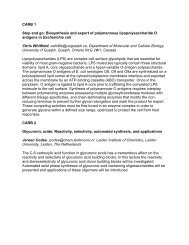American Chemical Society - Division of Carbohydrate Chemistry ...
American Chemical Society - Division of Carbohydrate Chemistry ...
American Chemical Society - Division of Carbohydrate Chemistry ...
You also want an ePaper? Increase the reach of your titles
YUMPU automatically turns print PDFs into web optimized ePapers that Google loves.
study <strong>of</strong> bioactive glycopeptides and semisynthetic glycoprotein conjugates.<br />
These studies will be presented with a focus on the effects <strong>of</strong> N-linked<br />
glycosylation on diabetes related peptides and glycosylated antibody fragments.<br />
N-linked glycosylation has proven to have some unexpected effects on the<br />
physical properties and bioactivity <strong>of</strong> glycoconjugates in these systems that may<br />
be useful in the development <strong>of</strong> glycopeptide and glycoprotein therapeutics.<br />
(1) Journal <strong>of</strong> the <strong>American</strong> <strong>Chemical</strong> <strong>Society</strong> 2010, 132, 3211-3216.<br />
(2) Journal <strong>of</strong> the <strong>American</strong> <strong>Chemical</strong> <strong>Society</strong> 2009, 131, 13616-13618.<br />
CARB 11<br />
Efficient chemoenzymatic synthesis <strong>of</strong> sialyl Lewis antigens using<br />
sialyltransferase mutants<br />
Xi Chen (1) , chen@chem.ucdavis.edu, One Shields Avenue, Davis CA 95616,<br />
United States ; Go Sugiarto (1) ; Kam Lau (1) ; Lei Zhang (1) ; Shengshu Huang (1) . (1)<br />
Department <strong>of</strong> <strong>Chemistry</strong>, University <strong>of</strong> Califorina-Davis, Davis California 95616,<br />
United States<br />
Sialic acids are a family <strong>of</strong> nine-carbon monosaccharides mainly found as the<br />
terminal residues <strong>of</strong> glycans on cell surfaces (1). More than 50 structurally<br />
distinct sialic acids have been found in nature (2, 3). Sialyl Lewis x is an important<br />
sialic acid-containing carbohydrate epitope involved in many biological processes<br />
such as inflammation (4) and cancer metastasis (5). Sialyl Lewis a is also involved<br />
in cancer progression (6). One <strong>of</strong> our research goals is to develop efficient<br />
chemoenzymatic method for the synthesis <strong>of</strong> sialyl Lewis x and sialyl Lewis a<br />
oligosaccharides containing structurally diverse sialic acid residues.<br />
The general biosynthetic pathway <strong>of</strong> sLe x and sLe a involves sialylation followed<br />
by fucosylation. In order to obtain sLe x and sLe a containing structurally diverse<br />
sialic acids, a more efficient approach would be to carry out the fucosylation<br />
before the sialylation so that different sialic acid forms can be introduced in the<br />
last glycosylation step. However, most sialyltransferases reported can not<br />
tolerate fucosylated substrates except for a viral alpha2,3-sialyltransferase (v-<br />
ST3Gal I) from myxoma virus (7). We have successfully cloned and expressed<br />
the v-ST3Gal I in E. coli. The enzyme has been used in the sialylation <strong>of</strong> Lewis x<br />
antigen. In addition, mutants <strong>of</strong> Pasteurella multocida sialyltransferase 1<br />
(PmST1), a multifunctional alpha2,3-sialyltransferase that has excellent<br />
expression level, solubility, and activity towards non-fucosylated substrates, have<br />
been designed and generated for direct sialylation <strong>of</strong> fucosylated<br />
oligosaccharides.<br />
1. Varki, A. (1997) Sialic acids as ligands in recognition phenomena, FASEB J.<br />
11, 248–255.<br />
2. Angata, T., and Varki, A. (2002) <strong>Chemical</strong> diversity in the sialic acids and




